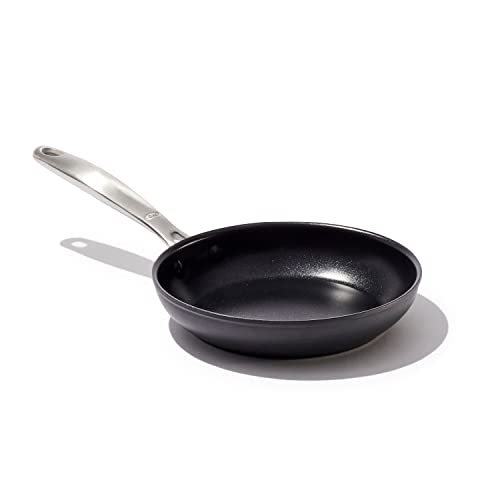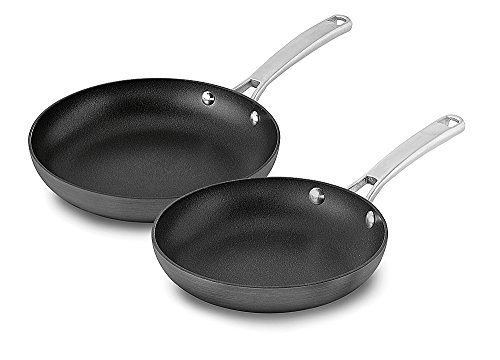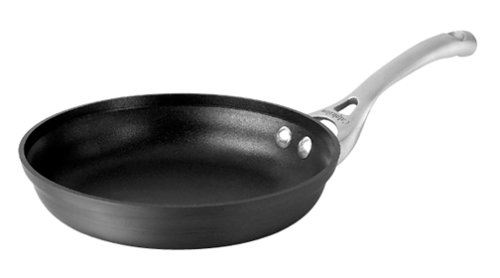Best Nonstick Omelette Pan For 2024
Brandon Forder Apr 19, 2024 11:53 AM
Although you might have a great frying pan, do you also have the greatest omelette pan?
Any good frying pan will suffice, but if you want to impress your guests with your omelettes, investing in the greatest omelette pan you can find is essential. Choose the best omelette pan for the job based on its even heating, solid construction, and ease of transfer from cooktop to oven.

Compare Products
- SCORE9.4
- BrandCalphalon
- Prime
- SCORE9.2
- BrandCalphalon
- Prime
- SCORE9.0
- BrandCalphalon
- Prime
- SCORE7.8
- BrandMinistry of Warehouse
- Prime
- SCORE6.6
- BrandFox Run
- Prime
Last update on 2024-04-19 / Affiliate links / Images, Product Titles, and Product Highlights from Amazon Product Advertising API
Type
Many variations of omelette makers exist. There's also the classic frying-pan-shaped spherical design. There is also the folding variety, which automatically flips when you fold one side over the other because to its clamshell shape. Tamagoyaki pans, the Japanese term for omelette pans, are either square or rectangular in shape, with slanted edges.
Material
Carbon steel, porcelain, copper, cast iron, and other materials are just some of the options for making this versatile kitchen tool. Read on to find out more about the features of each option so that you can make an educated decision.
Aluminum Pans
This model is quite effective at distributing heat and can help you save time in the kitchen. However, the acidity of some foods might be altered by cooking in such a pan.
Thankfully, anodized aluminum pans have been produced, which are even more efficient at transferring heat and do not alter the flavor of food.
Cast Iron Pans
This one is the best value in terms of price and durability. And because it is able to disperse heat so effectively, cast iron is also ideal for efficient cooking. They can be hefty, however, and the heating process could take a while.
Stainless Steel Pans
This material is not as good as others in thermal conductivity, yet it works well for an omelette pan. And it has a higher heat capacity, so your meal will stay hot for even longer.
Granite Stone Pans
This is the best choice if you're concerned about your family's health and well-being. They look great in your kitchen and have the same excellent durability as other materials. Pans made of granite stone are not only durable, but also resistant to even higher temperatures.
Ceramic Pans
Ceramic is another option for a safe and non-stick pan. To assure the highest possible level of safety when cooking and eating, they do not include any harmful chemicals like PFOA or PTFE. These pots and pans have a nonstick coating that makes them simple to clean by hand or in the dishwasher.
Carbon Steel Pans
Although it isn't as widespread as other options, many chefs around the world like using stainless steel pans. These are very identical to their cast-iron counterparts, but with the added benefit of being lighter and more manageable.
Non-stick Coating
To easily flip food, use a non-stick pan. Furthermore, washing a non-stick pan is a breeze. Seasoning, anodized aluminum, and Teflon are just some of the non-stick coating options.
Seasoning
Choose a pan made of stainless steel, cast iron, or carbon steel, and you'll find the words "pre-seasoned" on the label. This implies the pan has a non-stick coating that has been seasoned with natural oil.
If they haven't already been seasoned, you can do so in your own kitchen by placing a small amount of oil on the top and cooking them over medium heat until the oil begins to smoke. Then, remove the oil and set it aside to cool.
Anodized Aluminum
There is a non-stick coating that is extremely long-lasting and can be cleaned with normal dish soap and water. They can be used in the oven and on the stovetop without incident.
Teflon
Teflon-coated pans are typically less expensive than their anodized aluminum counterparts since the coating is not as durable and does not work as well when subjected to intense heat. They are easy to clean and don't contain any PFOA.
Size
Most high-quality omelette pans are between 8 and 12 inches in diameter. An omelette made in an 8-inch pan can serve two people, whereas an omelette made in a 12-inch pan can serve four.
The best omelette pans may be used for more than just scrambled eggs; they can also be used to make grilled sandwiches, crêpes, and other dishes on the stovetop. When deciding on the optimal omelette pan size, it's helpful to think about other potential uses.
Handle
Having a pan with a handle you can quickly and securely grab is essential for producing perfectly folded eggs, but a solid, well-designed handle is desired for pans of many functions and sizes. The most effective handles have a long reach and a moderate amount of heft.
Bottom Design
To ensure that your eggs cook evenly, you should use a skillet that has a flat, thick bottom and is somewhat wide in relation to the side walls.
Durability
Your pans may not endure forever because nothing is flawless. Cast-iron, hard-anodized aluminum, and stainless steel are all excellent options because of their great durability.
Good maintenance treatment is also necessary for the non-stick coating to last as long as possible. Cookware is best washed by hand using a soft sponge, water, and a very small amount of dish detergent. Keep the temperature down and don't use metal utensils too much.
What is the difference between an omelette pan and a frying pan?
Little, and the terms are frequently interchanged. While both types of pans benefit from nonstick materials or coatings, an omelette pan's gently sloping edges make it easier to flip eggs without breaking them, while a frying pan's straight sides keep food from spilling out.
How do I clean my omelette pan?
Some can be cleaned in a dishwasher, but this varies widely depending on the type of pan and the manufacturer's recommendations. When cleaning with a nonstick surface, never use abrasive materials like a sponge or brush.
What size pan should I use for omelettes?
An 8- or 9-inch omelette pan is ideal for use when cooking for fewer people. There's enough room for two or three eggs and some fixings. Choose a 10-12 inch pan for a more substantial serving size. You can prepare four or more portions at once using them.
Do you need a non-stick pan for omelettes?
When making omelettes, a skillet made of non-stick material is useful since it keeps the eggs, cheese, and meat from adhering to the pan as you turn and serve the meal. By coating the bottom of a standard omelette pan with a neutral cooking oil like olive or canola, you can make the surface of the pan more resistant to sticking. Doing so will prevent your eggs from sticking and give them a nice golden brown hue around the outside.
Are omelette pans expensive?
The brand, material, and type of pan you select will all play a role. As a result, it can be found at a range of prices. But if you can afford it, get a high-end one with a sturdy construction and great quality so you won't have to worry about buying a replacement for a long time.
You'll be able to make omelettes quickly and easily for every meal of the day once you have the greatest omelette pan. To add a touch of international flair to your standard meals, try substituting meat, cheese, and fresh vegetables from your preferred cultural cuisines.
The greatest omelette pans are made to be used in inventive ways, so don't be scared to try new things. And keep in mind that you'll need to crack a few eggs if you want to make the greatest omelette possible in the best omelette pan available.





























